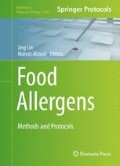Abstract
The methylotropic yeast Pichia pastoris has been extensively used in large-scale production of properly folded recombinant proteins. As an eukaryotic organism P. pastoris presents a series of advantages at expression and processing of heterologous proteins such as post-translational modifications, protein processing, and a reasonably sophisticated quality control of protein folding when compared against Escherichia coli. In this chapter, we describe the modified lab procedure for cloning and expression in Pichia pastoris of common food allergens sequences from the raw fruit to the fully folded biotinylated protein product.
Access this chapter
Tax calculation will be finalised at checkout
Purchases are for personal use only
References
Cai H, Chen L, Wan L et al (2009) High-level expression of a functional humanized anti-CTLA4 single-chain variable fragment antibody in Pichia pastoris. Appl Microbiol Biotechnol 82(1):41–48
Cregg JM, Cereghino JL, Shi JY et al (2000) Recombinant protein expression in Pichia pastoris. Mol Biotechnol 16(1):23–52
Ellis SB, Brust PF, Koutz PJ et al (1985) Isolation of alcohol oxidase and 2 other methanol regulatable genes from the yeast pichia-pastoris. Mol Cell Biol 5(5):1111–1121
Koutz P, Davis GR, Stillman C et al (1989) Structural comparison of the pichia-pastoris alcohol oxidase genes. Yeast 5(3):167–177
Tschopp JF, Brust PF, Cregg JM et al (1987) Expression of the lacz gene from 2 methanol-regulated promoters in pichia-pastoris. Nucleic Acids Res 15(9):3859–3876
Tschopp JF, Sverlow G, Kosson R et al (1987) High-level secretion of glycosylated invertase in the methylotrophic yeast, pichia-pastoris. Bio-Technol 5(12):1305–1308
Beckett D, Kovaleva E, Schatz PJ (1999) A minimal peptide substrate in biotin holoenzyme synthetase-catalyzed biotinylation. Protein Sci 8(4):921–929
Cull MG, Schatz PJ (2000) Biotinylation of proteins in vivo and in vitro using small peptide tags. Methods Enzymol 326:430–440. doi:10.1016/S0076-6879(00)26068-0
Chapman-Smith A, Mulhern TD, Whelan F et al (2001) The C-terminal domain of biotin protein ligase from E-coli is required for catalytic activity. Protein Sci 10(12):2608–2617
Predonzani A, Arnoldi F, Lopez-Requena A et al (2008) In vivo site-specific biotinylation of proteins within the secretory pathway using a single vector system. BMC Biotechnol 8:41. doi:10.1186/1472-6750-8-41
Scholle MD, Kriplani U, Pabon A et al (2006) Mapping protease substrates by using a biotinylated phage substrate library. Chembiochem 7(5):834–838
Thie H, Binius S, Schirrmann T et al (2009) Multimerization domains for antibody phage display and antibody production. N Biotechnol 26(6):314–321
de la Cruz S, Cubillos-Zapata C, Lopez-Calleja IM et al (2015) Isolation of recombinant antibody fragments (scFv) by phage display technology for detection of almond allergens in food products. Food Control 54:322–330
de la Cruz S, Alcocer M, Madrid R et al (2016) Production of in vivo biotinylated scFv specific to almond (Prunus dulcis) proteins by recombinant Pichia pastoris. J Biotechnol 227:112–119
Cregg JM and Russell KA (1998) Transformation, in Methods in Molecular BiologyTM; Pichia protocols. In: D.R. Higgins and J.M. Cregg (eds). pp. 27–39
Arbulu S, Jimenez JJ, Gutiez L et al (2015) Cloning and expression of synthetic genes encoding the broad antimicrobial spectrum bacteriocins SRCAM 602, OR-7, E-760, and L-1077, by Recombinant Pichia pastoris. Biomed Res Int 015:767183
Author information
Authors and Affiliations
Corresponding author
Editor information
Editors and Affiliations
Rights and permissions
Copyright information
© 2017 Springer Science+Business Media LLC
About this protocol
Cite this protocol
Neophytou, M., Alcocer, M. (2017). Recombinant Allergens Production in Yeast. In: Lin, J., Alcocer, M. (eds) Food Allergens. Methods in Molecular Biology, vol 1592. Humana Press, New York, NY. https://doi.org/10.1007/978-1-4939-6925-8_4
Download citation
DOI: https://doi.org/10.1007/978-1-4939-6925-8_4
Published:
Publisher Name: Humana Press, New York, NY
Print ISBN: 978-1-4939-6923-4
Online ISBN: 978-1-4939-6925-8
eBook Packages: Springer Protocols

